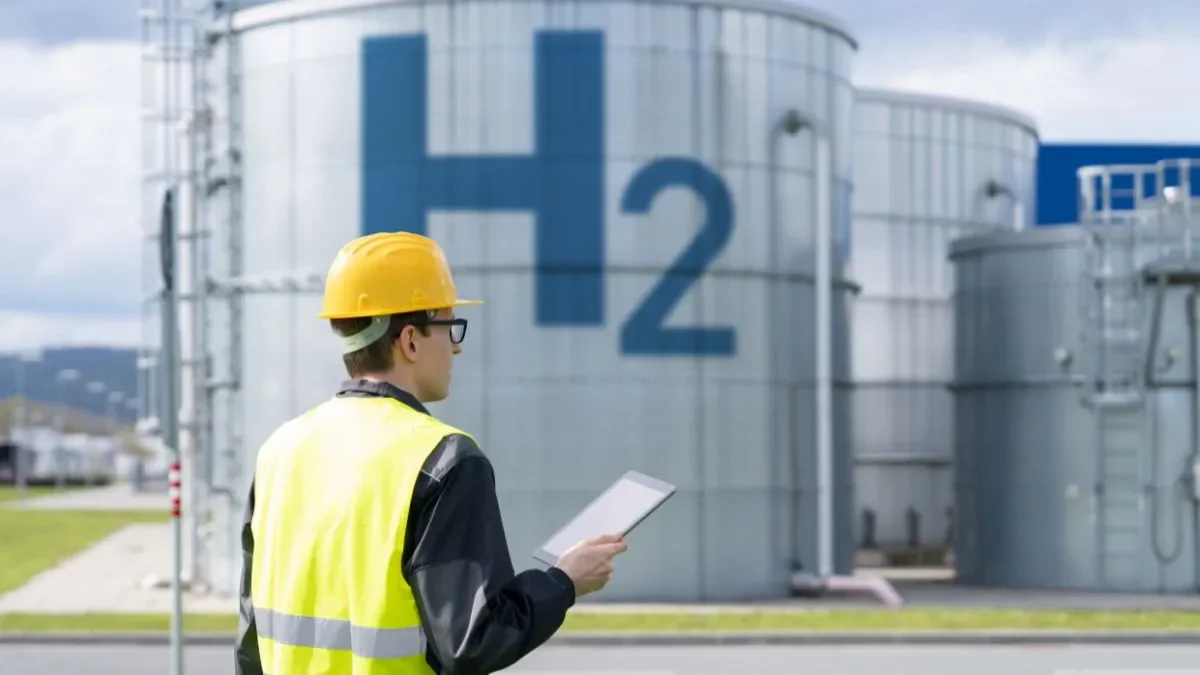Green hydrogen is making headlines. This clean energy source could transform how we power our world. Produced using renewable methods, green hydrogen offers a way to reduce carbon emissions and combat climate change. Let’s dive into what green hydrogen is, how it’s produced, its benefits, and its potential to shape our energy future.
What is Green Hydrogen?
Green hydrogen is hydrogen gas created through electrolysis. This process uses electricity from renewable sources like wind, solar, or hydropower to split water into hydrogen and oxygen. The result is a clean, carbon-free energy source.
How is Green Hydrogen Produced?
The production of green hydrogen involves a simple but powerful process. Water molecules (H2O) are split into hydrogen (H2) and oxygen (O2) using an electrolyzer. This device runs on renewable energy, ensuring the entire process remains environmentally friendly.
Benefits of Green Hydrogen
Green hydrogen offers many benefits. Let’s explore some key advantages:
Zero Emissions
Green hydrogen produces zero emissions. When used as fuel, it only releases water vapor. This makes it an excellent choice for reducing air pollution and greenhouse gases.
Versatile Energy Source
Green hydrogen is versatile. It can be used in various sectors, including transportation, industry, and power generation. It’s easy to store and transport, making it a reliable energy source.
Energy Storage
Renewable energy sources like wind and solar are intermittent. They don’t produce energy all the time. Green hydrogen can store excess energy produced during peak times. This stored energy can be used when renewable energy isn’t available.
Challenges Facing Green Hydrogen
Despite its many benefits, green hydrogen faces several challenges:
Cost of Production
Currently, producing green hydrogen is expensive. Traditional hydrogen production methods, which rely on fossil fuels, are cheaper. However, as technology advances and renewable energy costs decrease, green hydrogen will become more cost-competitive.
Infrastructure
The widespread use of green hydrogen requires significant investment in infrastructure. This includes production facilities, storage, and distribution networks. Developing this infrastructure is a major challenge but necessary for the transition to a hydrogen economy.
The Future of Green Hydrogen

Despite the challenges, the future of green hydrogen looks promising. Governments and private companies worldwide are investing in research and development. They aim to make green hydrogen a viable energy source. With the right support and advancements, green hydrogen could play a crucial role in achieving global sustainability goals.
Real-World Applications of Green Hydrogen
Green hydrogen has many real-world applications. Here are some key areas where it can make a significant impact:
Transportation
Green hydrogen can power fuel cell electric vehicles (FCEVs). These vehicles offer a zero-emission alternative to traditional gasoline and diesel engines. Companies like Toyota and Hyundai are already developing hydrogen-powered cars. Several countries are investing in hydrogen-powered public transportation.
Industrial Use
Industries such as steel and cement production contribute significantly to global carbon emissions. Green hydrogen can be used as a cleaner alternative to traditional fuels in these industries. This can help reduce their environmental impact.
Power Generation
Green hydrogen can be used in power plants to produce electricity. It offers a renewable alternative to fossil fuels, helping to decarbonize the energy sector. This supports the transition to a more sustainable energy system.
Overcoming Challenges and Scaling Up
For green hydrogen to reach its full potential, several hurdles must be overcome. Here are some strategies to address these challenges:
Reducing Production Costs
As technology advances, the cost of producing green hydrogen is expected to decrease. Research and development in electrolyzer technology are crucial. Improving efficiency and reducing material costs will make green hydrogen more affordable.
Expanding Infrastructure
Developing the necessary infrastructure is essential for the widespread use of green hydrogen. This includes building production facilities, storage systems, and distribution networks. Governments and private companies must invest in these areas to support the hydrogen economy.
Policy Support
Government policies play a crucial role in promoting green hydrogen. Incentives, subsidies, and regulations can encourage the adoption of green hydrogen technologies. International cooperation is also essential to create a global market for green hydrogen.
Success Stories and Innovations
Several success stories highlight the transformative potential of green hydrogen. Here are a few notable examples:
Germany’s Hydrogen Strategy
Germany has developed a national hydrogen strategy to support green hydrogen production and use. The country aims to become a global leader in hydrogen technology. Germany is investing billions in research, infrastructure, and international partnerships.
Hydrogen-Powered Trains
In 2018, Alstom launched the world’s first hydrogen-powered trains in Germany. These trains produce zero emissions, only emitting water vapor. They offer a sustainable alternative to diesel-powered trains.
Australia’s Hydrogen Roadmap
Australia is positioning itself as a major player in the global hydrogen market. The country has abundant renewable energy resources, making it an ideal location for green hydrogen production. Australia is developing a national hydrogen strategy to support this growing industry.
Green Hydrogen and the Environment
Green hydrogen offers significant environmental benefits. Here are some ways it can help protect our planet:
Reducing Greenhouse Gas Emissions
Green hydrogen can significantly reduce greenhouse gas emissions. Traditional hydrogen production methods release large amounts of carbon dioxide. In contrast, green hydrogen is produced using renewable energy, resulting in zero emissions.
Decreasing Air Pollution
Green hydrogen can help decrease air pollution in urban areas. When used in vehicles and power plants, it produces only water vapor. This can lead to cleaner air and improved public health.
Supporting Renewable Energy
Green hydrogen supports the growth of renewable energy. It provides a way to store excess energy produced by wind and solar farms. This stored energy can be used when renewable sources aren’t producing power, ensuring a reliable energy supply.
The Path Forward: Embracing Green Hydrogen
Embracing green hydrogen is crucial for a sustainable future. Here are some steps we can take to support this transition:
Investing in Research and Development
Continued investment in research and development is essential. This will drive technological advancements and reduce the cost of green hydrogen production. Governments, private companies, and academic institutions must collaborate to support innovation.
Building Public Awareness
Raising public awareness about the benefits of green hydrogen is crucial. Educating people about this clean energy source can encourage adoption and support for hydrogen technologies. Public campaigns and educational programs can help achieve this goal.
Fostering International Cooperation
International cooperation is vital for the global adoption of green hydrogen. Countries must work together to develop standards, share best practices, and create a global hydrogen market. Collaborative efforts can accelerate the transition to a hydrogen economy.
Cost of Production
Currently, producing green hydrogen is expensive. Traditional hydrogen production methods, which rely on fossil fuels, are cheaper. However, as technology advances and renewable energy costs decrease, green hydrogen will become more cost-competitive.
Infrastructure
The widespread use of green hydrogen requires significant investment in infrastructure. This includes production facilities, storage, and distribution networks. Developing this infrastructure is a major challenge but necessary for the transition to a hydrogen economy.
Real-World Applications of Green Hydrogen
Green hydrogen has many real-world applications. Here are some key areas where it can make a significant impact:
Transportation
Green hydrogen can power fuel cell electric vehicles (FCEVs). These vehicles offer a zero-emission alternative to traditional gasoline and diesel engines. Companies like Toyota and Hyundai are already developing hydrogen-powered cars. Several countries are investing in hydrogen-powered public transportation.
Industrial Use
Industries such as steel and cement production contribute significantly to global carbon emissions. Green hydrogen can be used as a cleaner alternative to traditional fuels in these industries. This can help reduce their environmental impact.
Power Generation
Green hydrogen can be used in power plants to produce electricity. It offers a renewable alternative to fossil fuels, helping to decarbonize the energy sector. This supports the transition to a more sustainable energy system.
Conclusion
Green hydrogen holds the potential to transform our energy landscape. It offers a clean, sustainable, and versatile energy source. While challenges remain, ongoing investments and technological advancements are paving the way for a hydrogen-powered future. By embracing green hydrogen, we can take significant steps toward achieving a sustainable and carbon-free world.
More Updates: https://www.timelinetale.com/


